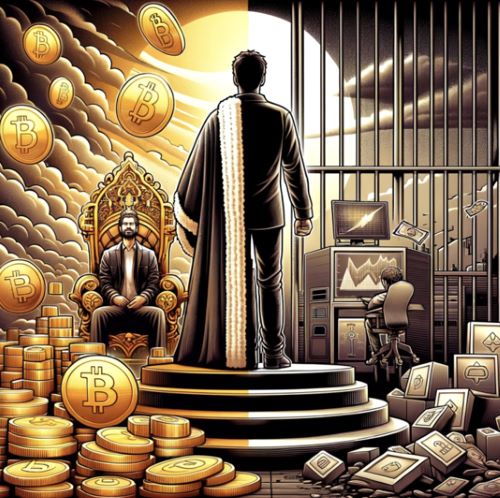

Just a few months ago, Sam Bankman-Fried, a 30-year-old billionaire and CEO of the cryptocurrency exchange FTX, was considered the star of the crypto scene. But the tables quickly turned as he went from industry leader to industry villain in a matter of days, losing his entire fortune and watching his billion-dollar company plunge into bankruptcy. He also became the target of one of the largest financial fraud cases in US history and will now face numerous court cases for which he could face a maximum sentence of 115 years in prison if found guilty.
How did someone who was once considered the biggest crypto mogul become a wanted crook, and what is the cautionary tale behind it? So let’s look at the crypto kingpin’s rapid fall from grace in detail here. If you’re interested in exploring the world of online casinos, you can check out Richard Casino’s promotions and use the bonus code Richard casino no deposit bonus to enhance your gaming experience.
The son of two Stanford law professors, Bankman-Fried grew up sheltered in Silicon Valley. He studied physics at the Massachusetts Institute of Technology, where he became particularly interested in a philosophical movement known as effective altruism, which uses computation to understand how people can use their time, money and resources to best help others.
After college, he worked for the global trading firm Jane Street, learning how to buy an asset in the market at a low price and then sell it in another market at a higher price, a method known as arbitrage. These skills became an integral part of his career, as he quickly realised that he could make money in the booming crypto market, where countless people were trading on private exchanges. He also noticed that some coins were selling at higher prices on some exchanges than others and realised that he could take advantage of these price differences.
So he jumped on the crypto bandwagon and founded his own crypto trading company “Alameda Research” in Berkeley, California. Despite the enormous volatility in turnover, crypto trading seemed like a safe bet, as its popularity has grown enormously since the emergence of Bitcoin in 2009.
Bitcoin has become the most recognised cryptocurrency in the world with more than 180 million users worldwide. This is used for both investment and trading purposes, as well as for a variety of transactions such as buying luxury goods and cars. It has even become a popular currency at online casinos, with more than 300 online casinos currently accepting Bitcoins as a form of payment, according to industry expert Casino Guru.
At its peak, Alameda was moving nearly $15 million a day between markets, earning Bankman-Fried the nickname “the Moby Dick of crypto whales”. He earned this nickname because he made so many waves within the crypto industry. In May 2019, he and his team then launched their own crypto exchange, FTX.
And everything went well until early 2022, as FTX and its US activities were valued by investors at a total of USD 40 billion thanks to the boom in Bitcoin and other digital assets at the time, according to Forbes. At his peak, Bankman-Fried’s own net worth was estimated at $26bn and he is said to have used some of this fortune for sponsorship, funding political elites and promoting his moral beliefs. With his strong belief in effective altruism, he even claimed to keep only 1% of his income, or at least $100,000 per year.
However, while Bankman-Fried’s rise continued unabated during these years, the crypto market was suddenly not as friendly as before, and by the end of 2022, things became particularly ominous for virtual currencies worldwide. An abrupt crash led to a loss in value of several billion US dollars in a very short space of time, with many investors affected by this huge price drop. At the centre of this collapse was FTX, which collapsed in early November following a wave of capital withdrawals.
A report issued by CoinDesk revealed that Bankman-Fried’s other company, Alameda Research, was also on shaky ground, pointing to potential leverage and solvency concerns. Traders were worried about a sudden drop in the value of FTT, FTX’s internal token in which most of Alameda’s assets were tied up, and this ultimately led to a massive loss of customers.
FTX ran out of capacity to launch a bailout and was forced to file for bankruptcy, with Bankman-Fried stepping down as CEO of the company. According to a filing with a US bankruptcy court, this collapse left FTX owing nearly $3.1 billion to its 50 largest creditors, with the largest creditor holding out for $226 million. Overnight, Bankman-Fried’s activities turned into a billion-dollar grave.
The implosion of this construct has since also led to allegations of fraud, which ultimately resulted in Bankman-Fried being arrested in the Bahamas on 12 December. Manhattan prosecutors accuse Bankman-Fried of stealing billions of dollars in FTX customer deposits to recoup losses at Alameda Research. And the charges also go as far as misleading lenders and investors, conspiring to launder money and violating US campaign finance laws.
On 21 December, he was extradited to New York, where he was released on bail for 250 million dollars the following day. Since then, former colleagues have pleaded guilty in connection with the case.
On 3 January, Bankman-Fried announced that he had pleaded not guilty to the charges. A planned trial is scheduled to begin on 2 October 2023, but it remains unclear what his defence strategy will be, as the burden of proof against him seems overwhelming and possible loopholes could also be found by his legal defence. Only time will tell what the future holds for the fallen crypto mogul.
Conclusion
The meteoric rise and catastrophic fall of Sam Bankman-Fried, once a celebrated figure in the cryptocurrency world, serves as a stark reminder of the volatile nature of the crypto market and the ethical responsibilities of those at its helm. Bankman-Fried’s journey from a billionaire CEO to a defendant facing serious charges underscores several key moral lessons.
Firstly, it highlights the dangers of hubris and overreach. Despite his early successes and reputation as a pioneer in the crypto space, Bankman-Fried’s downfall was precipitated by a series of risky decisions and alleged unethical practices. His story reminds us that success, no matter how grand, is fragile and can quickly be undone by complacency and disregard for ethical boundaries.
Secondly, the saga underscores the importance of transparency and integrity in business, especially in fields as complex and evolving as cryptocurrency. The allegations of fraud and mismanagement against Bankman-Fried not only led to his personal downfall but also eroded trust in the broader crypto market, affecting countless investors and stakeholders. This serves as a cautionary tale about the critical need for honesty, openness, and compliance with legal and ethical standards in business operations.
Finally, the case of Sam Bankman-Fried illustrates the broader societal implications of individual actions in the interconnected world of finance. His actions, and the subsequent collapse of FTX, had ripple effects across the global economy, affecting not just investors but also ordinary people who had placed their trust in the crypto market. This highlights the responsibility individuals in positions of power have towards society at large and the impact their decisions can have on a global scale. In conclusion, the story of Sam Bankman-Fried is a potent reminder of the perils of unchecked ambition, the necessity of ethical conduct in business, and the profound impact individual actions can have in our interconnected world. It serves as a cautionary tale for all, especially those in positions of influence and power, to act with integrity and awareness of their broader responsibilities.


